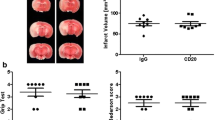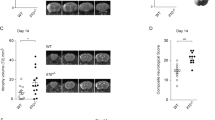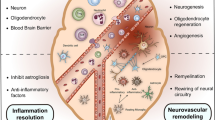Abstract
Clinical stroke induces inflammatory processes leading to cerebral and splenic injury and profound peripheral immunosuppression. IL-10 expression is elevated during major CNS diseases and limits inflammation in the brain. Recent evidence demonstrated that transfer of IL-10+ B-cells reduced infarct volume in male C57BL/6J (wild-type, WT) recipient mice when given 24 h prior to or 4 h after middle cerebral artery occlusion (MCAO). The purpose of this study was to determine if passively transferred IL-10+ B-cells can exert therapeutic and immunoregulatory effects when injected 24 h after MCAO induction in B-cell-sufficient male WT mice. The results demonstrated that IL-10+ B-cell treated mice had significantly reduced infarct volumes in the ipsilateral cortex and hemisphere and improved neurological deficits vs. Vehicle-treated control mice after 60 min occlusion and 96 h of reperfusion. The MCAO-protected B-cell recipient mice had less splenic atrophy and reduced numbers of activated, inflammatory T-cells, decreased infiltration of T-cells and a less inflammatory milieu in the ischemic hemispheres compared with Vehicle-treated control mice. These immunoregulatory changes occurred in concert with the predominant appearance of IL-10-secreting CD8+CD122+ Treg cells in both the spleen and the MCAO-affected brain hemisphere. This study for the first time demonstrates a major neuroprotective role for IL-10+ B-cells in treating MCAO in male WT mice at a time point well beyond the ~4 h tPA treatment window, leading to the generation of a dominant IL-10+CD8+CD122+ Treg population associated with spleen preservation and reduced CNS inflammation.








Similar content being viewed by others
Abbreviations
- CNS:
-
Central nervous system
- MCAO:
-
Middle cerebral artery occlusion
- WT:
-
wild-type Green Fluorescent Protein (GFP)
- TNF-α:
-
Tumor necrosis factor α
- INF-γ:
-
Interferon γ
- CD:
-
Cluster of Differentiation
- MHC II:
-
Major Histocompatibility Complex II
- RPMI:
-
Roswell Park Memorial Institute
- IL:
-
Interleukin
- PBS:
-
Phosphate-buffered saline
- DNase I:
-
Deoxyribonuclease I
- FACS:
-
Fluorescence Activated Cell Sorter
- PI:
-
propidium iodide.
References
Becker K, Kindrick D, Relton J, Harlan J, Winn R (2001) Antibody to the alpha4 integrin decreases infarct size in transient focal cerebral ischemia in rats. Stroke 32:206–11
Bodhankar S, Chen Y, Vandenbark AA, Murphy SJ, Offner H (2013) IL-10-producing B-cells limit CNS inflammation and infarct volume in experimental stroke. Metab Brain Dis 28:375–86
Bodhankar S, Chen Y, Vandenbark AA, Murphy SJ, Offner H (2014) Treatment of experimental stroke with IL-10-producing B-cells reduces infarct size and peripheral and CNS inflammation in wild-type B-cell-sufficient mice. Metab Brain Dis 29:59–73
Campanella M, Sciorati C, Tarozzo G, Beltramo M (2002) Flow cytometric analysis of inflammatory cells in ischemic rat brain. Stroke 33:586–92
Chen Y, Bodhankar S, Murphy SJ, Vandenbark AA, Alkayed NJ, Offner H (2012) Intrastriatal B-cell administration limits infarct size after stroke in B-cell deficient mice. Metab Brain Dis 27:487–93
Clark AW, Krekoski CA, Bou SS, Chapman KR, Edwards DR (1997) Increased gelatinase A (MMP-2) and gelatinase B (MMP-9) activities in human brain after focal ischemia. Neurosci Lett 238:53–6
Clarkson BD, Ling C, Shi Y, Harris MG, Rayasam A et al (2014) T cell-derived interleukin (IL)-21 promotes brain injury following stroke in mice. J Exp Med 211:595–604
Endharti AT, Rifa IM, Shi Z, Fukuoka Y, Nakahara Y et al (2005) Cutting edge: CD8 + CD122+ regulatory T cells produce IL-10 to suppress IFN-gamma production and proliferation of CD8+ T cells. J Immunol 175:7093–7
Endharti AT, Okuno Y, Shi Z, Misawa N, Toyokuni S et al (2011) CD8+ CD122+ regulatory T cells (Tregs) and CD4+ Tregs cooperatively prevent and cure CD4+ cell-induced colitis. J Immunol 186:41–52
Fang MC, Cutler DM, Rosen AB (2010) Trends in thrombolytic use for ischemic stroke in the United States. J Hosp Med 5:406–9
Grilli M, Barbieri I, Basudev H, Brusa R, Casati C et al (2000) Interleukin-10 modulates neuronal threshold of vulnerability to ischaemic damage. Eur J Neurosci 12:2265–72
Iadecola C, Anrather J (2011) The immunology of stroke: from mechanisms to translation. Nat Med 17:796–808
Jin R, Liu L, Zhang S, Nanda A, Li G (2013) Role of inflammation and its mediators in acute ischemic stroke. J Cardiovasc Transl Res 6:834–51
Kim JS, Yoon SS, Kim YH, Ryu JS (1996) Serial measurement of interleukin-6, transforming growth factor-beta, and S-100 protein in patients with acute stroke. Stroke 27:1553–7
Lee YH, Ishida Y, Rifa’i M, Shi Z, Isobe K, Suzuki H (2008) Essential role of CD8+ CD122+ regulatory T cells in the recovery from experimental autoimmune encephalomyelitis. J Immunol 180:825–32
Li P, Gan Y, Sun BL, Zhang F, Lu B et al (2013) Adoptive regulatory T-cell therapy protects against cerebral ischemia. Ann Neurol 74:458–71
Liesz A, Zhou W, Mracsko E, Karcher S, Bauer H et al (2011) Inhibition of lymphocyte trafficking shields the brain against deleterious neuroinflammation after stroke. Brain 134:704–20
Liesz A, Zhou W, Na SY, Hammerling GJ, Garbi N et al (2013) Boosting regulatory T cells limits neuroinflammation in permanent cortical stroke. J Neurosci 33:17350–62
Madan R, Demircik F, Surianarayanan S, Allen JL, Divanovic S et al (2009) Nonredundant roles for B cell-derived IL-10 in immune counter-regulation. J Immunol 183:2312–20
Mangalam AK, Luckey D, Giri S, Smart M, Pease LR et al (2012) Two discreet subsets of CD8 T cells modulate PLP (91–110) induced experimental autoimmune encephalomyelitis in HLA-DR3 transgenic mice. J Autoimmun 38:344–53
Minino AM, Murphy SL, Xu J, Kochanek KD (2011) Deaths: final data for 2008. Natl Vital Stat Rep 59:1–126
Offner H, Hurn PD (2012) A novel hypothesis: regulatory B lymphocytes shape outcome from experimental stroke. Transl Stroke Res 3:324–30
Offner H, Subramanian S, Parker SM, Afentoulis ME, Vandenbark AA, Hurn PD (2006a) Experimental stroke induces massive, rapid activation of the peripheral immune system. J Cereb Blood Flow Metab 26:654–65
Offner H, Subramanian S, Parker SM, Wang C, Afentoulis ME et al (2006b) Splenic atrophy in experimental stroke is accompanied by increased regulatory T cells and circulating macrophages. J Immunol 176:6523–31
Okuno Y, Murakoshi A, Negita M, Akane K, Kojima S, Suzuki H (2013) CD8+ CD122+ regulatory T cells contain clonally expanded cells with identical CDR3 sequences of the T-cell receptor beta-chain. Immunology 139:309–17
Ooboshi H, Ibayashi S, Shichita T, Kumai Y, Takada J et al (2005) Postischemic gene transfer of interleukin-10 protects against both focal and global brain ischemia. Circulation 111:913–9
Pelidou SH, Kostulas N, Matusevicius D, Kivisakk P, Kostulas V, Link H (1999) High levels of IL-10 secreting cells are present in blood in cerebrovascular diseases. Eur J Neurol 6:437–42
Ren X, Akiyoshi K, Dziennis S, Vandenbark AA, Herson PS et al (2011) Regulatory B cells limit CNS inflammation and neurologic deficits in murine experimental stroke. J Neurosci 31:8556–63
Rifa’i M, Kawamoto Y, Nakashima I, Suzuki H (2004) Essential roles of CD8 + CD122+ regulatory T cells in the maintenance of T cell homeostasis. J Exp Med 200:1123–34
Rosenberg GA, Navratil M, Barone F, Feuerstein G (1996) Proteolytic cascade enzymes increase in focal cerebral ischemia in rat. J Cereb Blood Flow Metab 16:360–6
Sattler S, Ling GS, Xu D, Hussaarts L, Romaine A et al (2014) IL-10-producing regulatory B cells induced by IL-33 (Breg (IL-33)) effectively attenuate mucosal inflammatory responses in the gut. J Autoimmun 50:107–22
Spera PA, Ellison JA, Feuerstein GZ, Barone FC (1998) IL-10 reduces rat brain injury following focal stroke. Neurosci Lett 251:189–92
Strle K, Zhou JH, Shen WH, Broussard SR, Johnson RW et al (2001) Interleukin-10 in the brain. Crit Rev Immunol 21:427–49
Subramanian S, Yates M, Vandenbark AA, Offner H (2011) Oestrogen-mediated protection of experimental autoimmune encephalomyelitis in the absence of Foxp3+ regulatory T cells implicates compensatory pathways including regulatory B cells. Immunology 132:340–7
Suzuki H, Shi Z, Okuno Y, Isobe K (2008) Are CD8+ CD122+ cells regulatory T cells or memory T cells? Hum Immunol 69:751–4
Van Exel E, Gussekloo J, de Craen AJ, Bootsma-van der Wiel A, Frolich M, Westendorp RG (2002) Inflammation and stroke: the Leiden 85-plus study. Stroke 33:1135–8
Yanaba K, Bouaziz JD, Haas KM, Poe JC, Fujimoto M, Tedder TF (2008) A regulatory B cell subset with a unique CD1dhiCD5+ phenotype controls T cell-dependent inflammatory responses. Immunity 28:639–50
Zhang B, Subramanian S, Dziennis S, Jia J, Uchida M et al (2010) Estradiol and G1 reduce infarct size and improve immunosuppression after experimental stroke. J Immunol 184:4087–94
Zhou W, Liesz A, Bauer H, Sommer C, Lahrmann B et al (2013) Postischemic brain infiltration of leukocyte subpopulations differs among murine permanent and transient focal cerebral ischemia models. Brain Pathol 23:34–44
Acknowledgments
The authors wish to thank Gail Kent for the submission of the manuscript. This work was supported by NIH/NINDS 1RO1 NS075887. This material is based upon work supported in part by the Department of Veterans Affairs, Veterans Health Administration, Office of Research and Development, Biomedical Laboratory Research and Development. The contents do not represent the views of the Department of Veterans Affairs or the United States Government.
Competing interests
The authors declare no competing financial interests
Authors’ contribution
SB designed and performed the immunology experiments, carried out statistical analyses, prepared graphics and wrote the manuscript; YC performed the MCAO procedures, carried out statistical analyses, prepared the graphics and wrote the methods and results for infarct volume data; AL assisted in tissue preparations and acquisition of immunological data; AAV critiqued and edited the manuscript; SJM and JAS directed study design and data analysis of the MCAO experiments and edited the manuscript; HO directed the overall study, supervised the immunological studies and data analysis and edited the manuscript. All authors read and approved the final version of the manuscript.
Author information
Authors and Affiliations
Corresponding author
Additional information
Sheetal Bodhankar and Yingxin Chen contributed equally to this work
Rights and permissions
About this article
Cite this article
Bodhankar, S., Chen, Y., Lapato, A. et al. Regulatory CD8+CD122+ T-cells predominate in CNS after treatment of experimental stroke in male mice with IL-10-secreting B-cells. Metab Brain Dis 30, 911–924 (2015). https://doi.org/10.1007/s11011-014-9639-8
Received:
Accepted:
Published:
Issue Date:
DOI: https://doi.org/10.1007/s11011-014-9639-8




